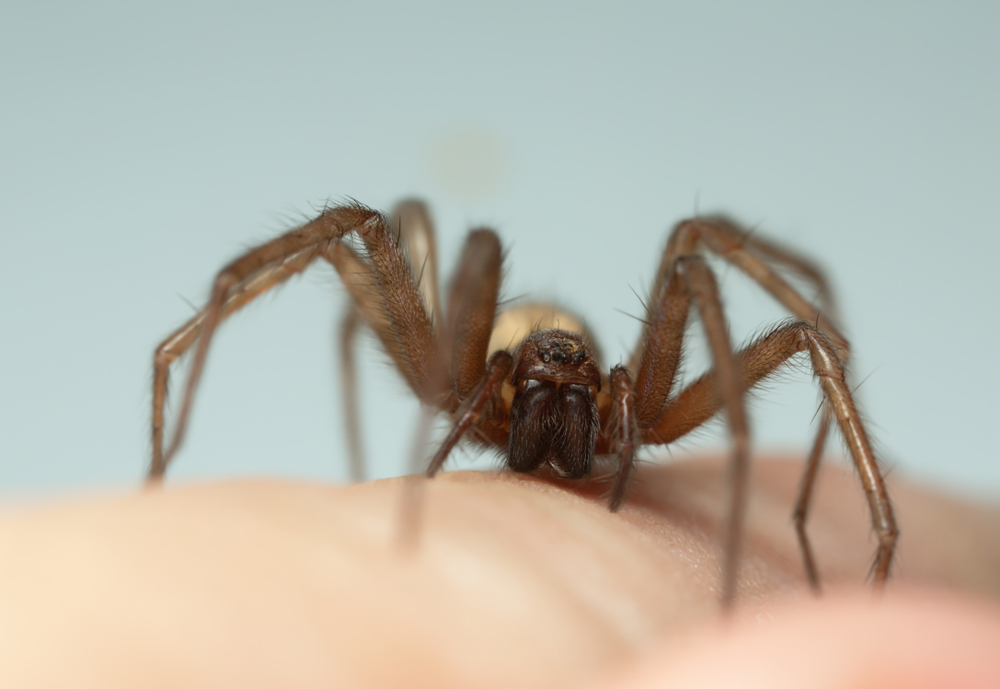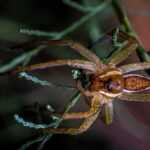Barn Funnel Weaver Spiders: Fascinating Household and Barn Inhabitants
Barn funnel weaver spiders are true masters of architecture, skillfully weaving their signature classic funnel web with remarkable precision inside buildings and barns. These webs aren’t just delicate silk sculptures—they serve as both a strategic hunting ground and a cozy hideaway, showcasing nature’s perfect blend of form and function. The classic funnel web radiating from a flat surface leads into a narrow funnel-like structure reaching into a corner or sheltered area where the spider sits patiently, ready to strike.
Are They Dangerous?
Despite their somewhat spooky appearance, barn funnel weaver spiders are more like quiet roommates than threats. This species, Tegenaria domestica, is rarely aggressive and prefers to avoid confrontation. Tegenaria species rarely bite, and when they do, their bites are generally harmless, causing only mild irritation similar to grass spider or wolf spider bites.
What Sets Barn Funnel Weavers Apart
With their typically dark orange to brown and gray hues, striking dark stripes, and sleek, elongated bodies, barn funnel weavers are surprisingly easy to recognize once you know what to look for. Their calm, non-aggressive demeanor and love for quiet indoor corners like barns and sheds have earned them a permanent spot in homes across the globe.
Spotting the Barn Funnel Weaver
Female body length averages between 10 and 20 millimeters, while male body length averages from 9 to 18 millimeters. Their mottled brown and gray bodies are adorned with prominent dark stripes running from front to back, giving them a classic yet mysterious look. The cephalothorax boasts shades of brown, tan, and yellow-brown, highlighted by two distinctive dark stripes that help set them apart from lookalikes. Their bloated and elongated abdomen and back-exposed spinnerets add to their unique silhouette. Males often sport darker markings on their undersides, with the appearance male underside being a useful identification trait, and their long, striped legs make them unmistakable once you know their style. As one of the smaller species in the Tegenaria genus, they are distinct species from their larger relatives.
Distribution and Habitat
Originally native to Europe, the barn funnel weaver spider’s global distribution encompasses Europe, southern Canada, and the United States, extending as far north as Scandinavia and as far south as the Mediterranean Sea. They have also been introduced to parts of Central Asia and other continents. These spiders thrive in quiet indoor spaces—basements, barns, sheds, and building crevices—favoring corners or suitable sheltered areas where they can spin their webs undisturbed. They are even recorded among Danish spider species and listed in the World Spider Catalog maintained by the Natural History Museum Bern.
Web Structure and Hunting Behavior
Their signature funnel-shaped webs are architectural marvels and deadly traps rolled into one. Picture a flat sheet of stressed silk threads spun over a flat surface, with a funnel-like structure reaching into a cozy corner or sheltered nook. The spider sits at the funnel tip, using both their vision and web mechanisms to detect vibrations signaling an unwelcome visitor. When prey disturbs the web, the spider darts out with lightning speed, capturing its meal with precision. This ingenious design serves as both a hunting ground and a fortress, maximizing their chances of survival. Their movement follows a continuous gait pattern interrupted by short pauses, allowing precise navigation of their territory.
Life Cycle and Reproduction
Barn funnel weaver spiders lead fascinating lives. Domestica spiders hatch from eggs laid in over nine egg sacs throughout a female’s life. Male numbers peak during the mating season, typically from May to July, indicating mating occurs in these months. Females regularly survive harsh conditions, dwelling indoors typically live for up to seven years in rarely disturbed places like basements or attics, with domestica females reportedly surviving for long periods, while males tend to have shorter lifespans. This longevity allows females to produce multiple generations and maintain their presence year after year.
Interaction with Humans
These spiders are shy, preferring to avoid human contact and retreat quickly when disturbed. Tegenaria species rarely bite, and their bites are generally harmless, causing only mild irritation. Far from being pests, barn funnel weavers are natural pest controllers, feeding on flies, crickets, and other insects that invade our homes. They even prey on invasive pests like the spotted lanternfly, making them valuable allies in protecting local ecosystems.
Defense Mechanisms
When threatened, barn funnel weaver spiders don’t pick fights—they pick escapes. Their speed and agility allow them to retreat swiftly into their funnel-shaped webs. If their web is partially destroyed, they may curl up against a nearby object or flee altogether. Their web’s design also acts as an early warning system, alerting them to danger through vibrations, giving them precious seconds to vanish.
Medical Importance: Harmless Spiders with Minimal Risk
Bites from barn funnel weaver spiders are extremely rare and medically insignificant. Their venom is mild, and their non-aggressive nature means they pose little risk to humans. Understanding this can help dispel fears and promote appreciation for these beneficial arachnids.
Fun Facts and Surprising Insights
- Barn funnel weavers are surprisingly fast and agile—when a fly lands on their web, it barely has a chance to escape!
- These spiders have been known to live up to seven years indoors, a rarity among spiders.
- Interestingly, barn funnel weavers are one of the few spiders that will prey on invasive pests like the spotted lanternfly, helping protect local ecosystems.
- Their webs are not sticky; they rely on speed and precision to catch prey.
- Males and females sometimes share the same web during mating season, cohabiting peacefully for a short time.
- Barn funnel weavers can distinguish between different types of vibrations on their webs, allowing them to differentiate between prey, predators, or potential mates.
- These spiders have excellent eyesight compared to many other spiders, with six of their eight eyes oriented forward to better detect movement.
- The funnel-shaped web also functions as a sensory extension, amplifying the vibrations and enabling the spider to detect prey from a distance.
- In colder climates, barn funnel weavers have adapted to survive indoors year-round, making use of human structures to escape harsh winters.
- They have been observed engaging in complex mating behaviors, including male courtship dances to avoid being mistaken for prey by females.
Behavioral Observations
Barn funnel weaver spiders exhibit intriguing social behaviors during mating season. Males often remain in the female’s web for a time, with both tolerating each other’s presence despite occasional leg contact that appears more agonistic than friendly. Outside mating season, these spiders are solitary and territorial, fiercely defending their funnel-shaped webs. Their ability to distinguish vibrations on their webs helps them identify whether an intruder is prey, a potential mate, or a threat, allowing them to respond appropriately.
Ecological Role: Beneficial Predators in Human Environments
Beyond just controlling household pests, barn funnel weaver spiders play an important ecological role by preying on a wide variety of arthropods, including flies, crickets, centipedes, and even other spiders. Their presence in barns and homes helps maintain a balanced ecosystem by naturally reducing populations of insects that can damage crops or spread disease. Their ability to prey on invasive species like the spotted lanternfly further underscores their value as natural pest controllers. Homeowners in regions like Las Vegas can benefit from integrating knowledge about these spiders with professional pest control services to effectively manage unwanted pests.
How to Coexist with Barn Funnel Weaver Spiders
Given their beneficial nature and low risk, it’s best to coexist peacefully with barn funnel weavers. To minimize unwanted encounters, reduce clutter where spiders can hide and keep indoor spaces tidy. If removal is necessary, gently capture spiders using a container lid and relocate them outdoors. Avoid using harsh chemicals indoors, as these can harm not only spiders but also other beneficial insects.
Differentiating from Similar Species
Barn funnel weavers can sometimes be confused with other brown spiders such as wolf spiders or hacklemesh weavers. Unlike wolf spiders, barn funnel weavers have thinner legs and lack the large posterior median eyes characteristic of wolf spiders. Hacklemesh weavers have shorter, thicker legs and do not build the classic funnel-shaped webs that barn funnel weavers do. Paying attention to the two dark stripes on the cephalothorax and the chevron pattern on the abdomen can help correctly identify barn funnel weavers.
Seasonal Behavior: Activity Patterns Throughout the Year
Barn funnel weavers are primarily nocturnal hunters, most active during the warmer months when males are on the move seeking mates. Mating usually occurs from May through July, after which males often die in autumn. Females remain in their webs year-round, especially indoors, where they can survive through winter. The spiders’ ability to adapt to indoor environments allows them to maintain populations even in colder climates.
More than just a common household guest, the barn funnel weaver spider plays a vital role in controlling insect populations. The barn funnel weaver spider’s unique appearance, clever web designs, and adaptive behaviors make it a fascinating creature worthy of admiration. By understanding the barn funnel weaver spider’s life cycle, hunting tactics, and gentle nature, we can coexist peacefully and even appreciate this remarkable spider as a helpful ally in our homes.
Frequently Asked Questions
Are barn funnel weaver spiders dangerous to humans?
No, the barn funnel weaver spider’s venom poses no significant threat, and these spiders rarely bite.
What does their venom do?
The barn funnel weaver spider’s venom is non-toxic to humans and causes only mild symptoms if bitten.
How can I identify a barn funnel weaver spider?
Look for a mottled brown and gray body with two dark stripes on the cephalothorax and noticeable spinnerets at the rear—classic signs of the barn funnel weaver spider.
Where do barn funnel weaver spiders typically live?
Barn funnel weaver spiders prefer sheltered indoor spaces such as basements, barns, sheds, and building crevices across Europe, Canada, and the U.S.
Can barn funnel weaver spiders help with pest control?
Absolutely! The barn funnel weaver spider preys on a variety of insects, including flies, crickets, and even invasive pests like the spotted lanternfly.




